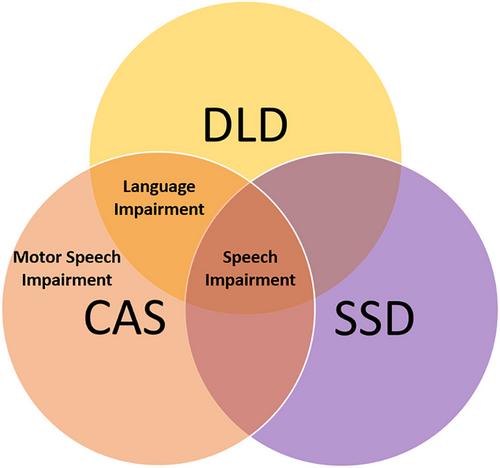Exploring vowel errors produced in nonword repetition in children with speech and language disorders
Abstract
Background
Accurate nonword repetition (NWR) is contingent on many underlying skills, including encoding, memory and motor planning and programming. Though vowel errors are frequently associated with childhood apraxia of speech (CAS), several recent studies have found that children with developmental language disorder (DLD) produce high rates of vowel errors in NWR tasks.
Aims
This retrospective analysis explored whether the overall frequency and types of vowel errors produced in NWR distinguish children with DLD, children with CAS, children with speech sound disorder (SSD) and children with typical development (TD).
Methods and Procedure
We present data for 24 children (six per DLD, CAS, SSD and TD groups), ranging in age from 50–92 months. Children with DLD, CAS and SSD showed similar articulation scores and children with DLD and children with CAS showed similar expressive language scores. Total vowel errors, total monophthong errors, monophthong substitutions, diphthongization errors, total diphthong errors, diphthong substitutions and diphthong reduction errors were calculated by syllable length and group. Repeated measures analyses of variance were used to examine group differences.
Outcomes and Results
Children with DLD and children with CAS produced a higher frequency of total vowel errors compared to children with TD. Children with DLD produced more total monophthong errors than children with TD. Children with DLD and children with CAS produced more total diphthong errors than children with TD. For children with DLD, these were characterised by diphthong substitutions. For children with CAS, these were characterised by diphthong substitutions and diphthong reduction errors. For all measures, error rates in children with SSD did not significantly differ from any of the other three groups.
Conclusion
Preliminary evidence indicates that children with DLD and children with CAS both show high rates of vowel errors in NWR tasks and weaknesses in encoding and memory. For children with CAS, additional motor planning difficulties are associated with an increased likelihood to reduce diphthongs. Children with SSD show more mild processing difficulties than children with DLD and children with CAS, though they do not perform as well as TD peers. Future work should replicate and further specify the processing weaknesses that affect vowel accuracy in NWR tasks in a larger sample.
WHAT THIS PAPER ADDS
What is already known on the subject
- Nonword repetition (NWR) tasks are often included in diagnostic batteries to identify children with developmental language disorder (DLD). Poor performance on these tasks have historically been attributed to phonological working memory deficits in children with DLD. However, repeating nonwords relies on a number of underlying processing skills and many of these skills are affected to varying degrees in children with speech and language disorders. An in-depth analysis of vowel errors has the potential to reveal the shared as well as specific underlying processing weaknesses in children with DLD, children with childhood apraxia of speech (CAS) and children with speech sound disorder (SSD).
What this paper adds to existing knowledge
- We found that children with DLD and children with CAS show low vowel competence compared to children with typical development. A nuanced examination of vowel error types further revealed that children with DLD and children with CAS show weaknesses in encoding and memory. Motor planning and programming weaknesses were unique to CAS. Children with SSD show more mild processing deficits and their performance did not significantly differ from any of the other three groups.
What are the clinical implications of this work?
- Examining the types of vowel errors produced by children with DLD, children with CAS and children with SSD in NWR allows us to further specify the underlying processing weaknesses that differentiate these three groups. This research informs theoretical accounts of language processing in children with different types of speech and language disorders and has the potential to improve the diagnostic utility of NWR tasks.


 求助内容:
求助内容: 应助结果提醒方式:
应助结果提醒方式:


